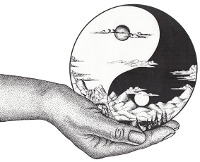Root yourself to the Earth. Find flexibility in the being open to the changes of the Universe.
Tag Archives: tai chi principles
Roles of Body and Mind in Tai Chi
When you first start to study tai chi the body informs the mind – this is done by what you feel and see when scanning the body for tension, checking your weight differentiation and foot placements, monitoring your alignment, and coordinating the body mechanics from the vertical and horizontal axis. After a period of time […]
Principles of Meditation
Meditation is a change in the “state of mind”. IMHO in meditation, sitting, standing or moving, when one experiences “non thinking” it is simply that the mind is not focused on internal dialogue. There are dimensions to what might be considered dialogue… In tai chi, the dialogue could be too much focus on what you […]
8 Methods – Professor Cheng Man-Ching
Believed to have been lost, the 8 Methods is a set of images and movements created by Professor Cheng Man-Ching. It was developed to add imagery to and simplify the tai chi basic principles for people who may have memory challenges, those who had suffered injury and are in rehab, and as an simple introduction […]
A Few Moves – Master Young
Click here – movements – ST 2014 Become a subscriber and you will get a link to watch Cheng wen-Ming do the form.
Advanced Principle of Tai Chi
One advanced principle of tai chi that states – Mind arrives, eyes arrives, hands arrive (manifested posture) – this refers to the aspect of the mind that not only coordinate, but propels the form. Be aware of this current of motivation and continuity, but if you get too distant in visioning what comes next you loses the mindfulness […]
Changes
“Perfection is the enemy of good.” Fear of Art This is not to say that we should not strive to become better in our arts, however if we are don’t practice for fear of being wrong then we are destined to quit. On my journey for over 46 years, I still leave myself open for […]
Hip Tip
Here’s a “hip” tip. In 80% of the Yang-Style Short Form, at the end of a posture, the hips are square to the direction you are facing. In transition the hips should remain level. In motion, the waist/hips guide the direction of the limbs. The hips are synonymous with the waist. The waist/hips is the […]
